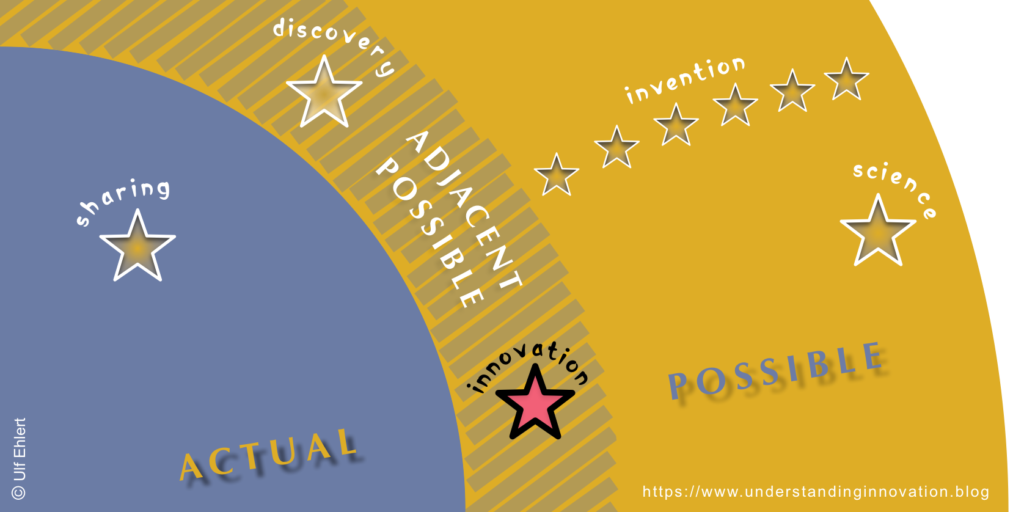Adjacent Potential
There is a world of infinite possibilities available to all of us on any given day at any given moment.
As much as we would all like to believe that ideas are singular and spontaneous moments of insight and genius, that simply isn’t true. Ideas form in networks. This is the concept of the adjacent potential, which originated from Stuart Kauffman’s work with biological evolution. Without getting too technical and scientific, Kauffman, a theoretical biologists, is interested in biological self-organization and the origins of order in nature. He describes a system that is interconnected and how opportunities for growth or evolution are only available because they expand on what is currently available. These innovations build new connections upon existing elements (for a more detailed description, see The Origins of Order: Self-Organization and Selection in Evolution).
In his book How We Got to Now: Six Innovations that Made the Modern World, Steven Johnson simplifies the adjacent potential in order to illustrate how various innovations came to fruition. He explains:
The adjacent possible is a kind of shadow future, hovering on the edges of the present state of things, a map of all the ways in which the present can reinvent itself.
The strange and beautiful truth about the adjacent possible is that its boundaries grow as you explore them. Each new combination opens up the possibility of other new combinations.
In other words, “generating new ideas is a process of looking for ideas that are adjacent to ideas that are already out there” (Tony Kuhon, 2013). This suggests that any idea (even the absolutely crazy ones) are possible, but only once you have explored your current surroundings, ideas, and new learnings.

There are lots of examples of the adjacent potential. For example, if YouTube was launched in the mid 1990s, it would not have been successful because we did not have the Internet, nor the software (or mindset) to watch videos online. Think about the printing press. The printing press was only possible once moveable type, paper and ink all existed. Before those other innovations, the idea of mass-producing text was unthinkable!
So, what does this mean in the classroom? How do we capture students’ creative potential so that they experience breakthrough ideas throughout the school year?
Allow for cross-pollination
Flash. Stroke of genius. Epiphany. The lightbulb moment. Eureka! These are all the metaphors we have used to describe having an idea, especially an innovative or creative idea. Ideas are not single things. They do not occur in illuminating moments of inspiration. An idea is a network. A brand-new idea is a new configuration of neural networks firing inside your brain that have never fired in this particular configuration before. How do we create a classroom environment that encourages lots of innovation and creativity?Innovation occurs when we “take ideas from other people, from people we’ve learned from, from people we run into in the coffee shop, and we stitch them together into new forms and we create something new” (Johnson, 2010). Students come to us with tons of random bits of knowledge and information from a myriad of unique experiences. In order for them to be able to combine these experiences in unique ways to form creative ideas, we need to structure our classrooms to encourage cross-pollination. Think of hummingbirds. They fly from flower to flower drinking nectar throughout the day. By doing this, they are inadvertently taking bits of pollen or seeds from one place and transporting it to new locations. Flowers then flourish wherever the hummingbird went. In order for ideas to flourish, we need to create a “liquid network” where students can collaborate and pick up bits of information from a variety of classmates and subjects, and then have many opportunities to share their thinking and recombine ideas in novel ways.
Sit with hunches
Great ideas almost never occur in a Eureka! moment. Instead, many breakthrough ideas take a long time to evolve, marinating in our brains before we turn them into a specific innovation. It is important to teach students that not all ideas are big blasts of inspiration. It’s okay (even important) to be curious about a hunch, sit with it for a while and explore the possibilities. Steven Johnson tells us that innovative ideas are born out of collisions of other, sometimes smaller ideas. Ideas need time to incubate and we, as teachers, need to allow for exploration and curiosity. This is often difficult because public education revolves around strict timetables and standardized testing. However, if we create expectations in our classroom that students should be thinking about their thinking (metacognition), we give them natural chances to sit with a hunch.Instead of rushing students to regurgitate answers (or even creative ideas), we should be encouraging them to collaborate with other, sharing their hunches with their classmates. When multiple hunches collide, this can be the start of a spectacular idea.
Encourage collaboration
When two or more people are voluntarily working together towards a shared goal, they are collaborating. Collaboration is such an important skill, both for students and adults, because we live in a world of design-thinking. Although human beings are social creatures, collaboration isn’t necessarily easy for everyone; however, true innovation comes from being a part of a learning community where there is time to think critically and re-energize our love of learning. If we force students to work in isolation, we are robbing them of the opportunity to share, support their classmates, learn together, and be creative and innovative. We want students to exchange ideas and insights with each other. This can happen in the cafeteria and on the playground. You may argue that lunch and recess are social, but not much deep learning is taking place. I disagree. In these environments, students are learning about sharing and testing ideas; collaborating with their peers.
At its best, learning is a social act. Student collaboration and discussion are essential elements of an engaging classroom experience and promote deep understanding. Having a structure for collaboration is the best way to ensure that your students are able to continually collaborate across a variety of topics/problems.
Encourage failing
Failure is part of the learning cycle. We all use what we learn from our first try to help us redesign better solutions to problems we are facing. Not only should you create a classroom environment that encourages failing, you should embrace failure as a necessary part of all learning. Being innovative has never meant being fearless. Pushing through our fear of failure is a huge part of creativity, innovation, and changing the world. We all love guarantees, but if you want to do something that no one has ever done before, or create something out of nothing, or inspire people by your ideas and actions, then you need to be uncertain and live in that uncertainty. Not only is it important to teach your students to ask themselves Am I sure this is going to work, it is also vital that we (as educators) practice and model living in that discomfort of things not working. Being innovative is not about never failing; being innovative is about failing over and over and over and over again.
Remix
We need to get rid of the idea that new ideas need to be completely new. How often have you thought, Everything cool has already been invented or while trying to solve a problem, you discover that a solution you didn’t know about already exists? This happens all the time in the classroom. Students come up with what they think is an amazing idea only to have another classmate (or teacher) tell them that it already exists. The result is a crushing blow to their creativity. So much of creativity is about taking what already exists and remixing to to create something different. I love the video series Everything is a Remix! Since it first came out five years ago, there have been more and more examples added about how things, concepts, scenes in movies, and songs once originated (partially) in something else. For example, the original video contains tons of musical melodies that have been borrowed to create new songs.
We need to encourage remixing in the classroom. Just because an idea exists, does not mean that we cannot make it better. In fact, many students (including me) often work more creatively when given an existing template of sorts. Instead of asking students to create new every time, we should ask them, How can you take this and make it better/use it in a different context? If you want research supporting the idea of remixing, “evolutionary biologists use the term expatiation to describe the phenomenon where a trait originally developed for a specific purpose is eventually used in a completely different way. Feathers, for example originally evolved as a method for temperature regulation, but today their airfoil-shape helps birds fly” (Blinkist, 2013).

Almost any student will recognize the genius of Thomas Edison. “He invented the lightbulb!” they’d say. In fact, as Steven Johnson explains, Edison’s “greatest achievement may have been the way he figured out how to make teams creative: assembling diverse skills in a work environment that valued experimentation and accepted failure, incentivizing the group with financial rewards that were aligned with the overall success of the organization, and building on ideas that originated elsewhere” (Johnson, 2010, p. 212). Instead of inventing the lightbulb singlehandedly, Edison created a system for fostering innovation and creativity in others. Imagine a classroom where student are guided by intuition; leading them to trigger positive chain reactions of innovation. When you structure your classroom for the adjacent potential, you are communicating to your students that invention and iteration go hand in hand. “Big ideas coalesce out of smaller breakthroughs” (Johnson, 2010, p. 213). The physicist, Vittorio Loreto, describes the metaphor of having “waves of novelties” while the “tides hold the classics” (Loreto, 2018). He means that new ideas come from sitting with old ideas every day and connecting them with other ideas (he recommends spending 80% revisiting old ideas and 20% exploring new ideas). Periodically, we will experience a wave (new idea) and this can then be recombined with “the classics” (older ideas) in order to form something radically innovative.
The adjacent potential captures both the limits and creative potential of change and innovation. By structuring your classroom so that ideas flow naturally, you will automatically encourage students to be more creative through increased productive interactions with each other. When students are allowed time and space to play around with their collective ideas, innovative solutions (and your students) flourish. One idea leads to another and another and another. Be prepared to get out of the way from the flood of creative ideas and innovative thinking that will emanate from each and every one of your students!
Works Cited
Blinkist. (2013, November 27). The key lessons from “Where Good Ideas Come From” by Steven Johnson. Retrieved from https://medium.com/key-lessons-from-books/the-key-lessons-from-where-good-ideas-come-from-by-steven-johnson-1798e11becdb
Ehlert, U. (2019, March 17). Exploring the adjacent possible – How we make progress. Retrieved from https://understandinginnovation.blog/2019/02/28/exploring-the-adjacent-possible-how-we-make-progress/
Johnson, S. (2010). Where Good Ideas Come From. Retreived from https://www.ted.com/talks/steven_johnson_where_good_ideas_come_from/up-next?language=en
Loreto, V. (2018). Need a new idea? Start at the edge of what is known.Retrieved from https://www.ted.com/talks/vittorio_loreto_need_a_new_idea_start_at_the_edge_of_what_is_known

 Previous Post
Previous Post